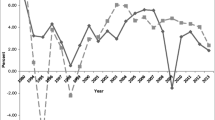Abstract
This paper investigates the Keynesian view and the Wagner’s Law on the role of public expenditure on economic growth for Malaysia (1970–2004). The empirical results using the Auto-Regression Distributed Lag (ARDL) model and the ‘bounds test’ (Pesaran et al. in J Appl Econ 16:289–326, 2001) showed evidence of a long run relationship between total expenditures (including expenditures on defense, education, development and agriculture) and Gross National Product. The results also show that with the structural break in 1998, the long run causality is bi-directional for GNP and expenditures on administration and health, supporting both Keynes view and Wagner’s Law. For all other expenditure categories the long run causality runs from GNP to the expenditures, which supports Wagner’s Law.
Similar content being viewed by others
References
Abu-Bader S, Abu-Qarn A (2003) Government expenditures, military spending and economic growth: causality evidence from Egypt, Israel and Syria. J Policy Model 25: 567–583
Ahsan S, Kwan A, Sahni B (1989) Causality between government consumption expenditures and national income: OECD countries. Public Financ 44(2): 204–224
Akaike H (1973) Information theory and an extension of the maximum likelihood principle. In: Petrov B, Csake F(eds) International symposium on information theory. Akademiai Kiado, Budapest
Ansari M, Gordon D, Akuamoah C (1997) Keynes versus Wagner: public expenditure and national income for three African countries. Appl Econ 29: 543–550
Bank Negara Malaysia (1970–2004) BNM annual report. http://www.bnm.gov.my
Bardsen G (1989) Estimation of long-run coefficients in error correction models. Oxf Bull Econ Stat 51: 345–350
Barth JR, Keleher RE, Russek FS (1990) The scale of government and economic activity. South Econ J 13: 142–183
Bharat K, Panik M, Wahab M (2000) Government expenditure and economic growth: evidence from G7 countries. Appl Econ 32(8): 1059–1068
Chang T, Liu W, Caudill S (2004) A re-examination of Wagner’s law for ten countries based on cointegration and error-correction modeling technique. Appl Financ Econ 14: 577–589
Department of Statistics Malaysia (1970–2004) Yearbook of statistics Malaysia. http://www.statistics.gov.my
Dritsakis N, Adamopoulos A (2004) A causal relationship between government spending and economic development: an empirical examination of the Greek economy. Appl Econ 36: 457–464
Engle R, Granger C (1987) Cointegration and error correction: representation, estimation and testing. Econometrica 55: 251–276
Gandhi V (1971) Wagner’s law of public expenditure: do recent cross section studies confirm it?. Public Financ 26: 44–55
Ghali K (1999) Government size and economic growth: evidence from a multivariate cointegration analysis. Appl Econ 31: 975–987
Granger C (1969) Investigating causal relations by econometric models and cross spectral methods. Econometrica 37: 424–438
Gregory AW, Hansen BE (1996a) Residual-based tests for cointegration in models with regime shifts. J Econom 70: 99–126
Gregory AW, Hansen BE (1996b) Tests for cointegration in models with regime and trend shifts. Oxf Bull Econ Stat 58: 555–559
Gupta S (1967) Public expenditure and economic growth: a time-series analysis. Public Financ 22:423–426
Holmes JM, Hutton PA (1990) On the causal relationship between government expenditures and national income. Rev Econ Stat 72(1): 87–95
Hondroyiannis G, Papapetrou E (1995) An examination of Wagner’s law for Greece: a cointegration analysis. Public Financ 50(1): 67–79
Johansen S (1988) Statistical analysis of cointegration vectors. J Econ Dyn Control 12: 176–181
Johansen S, Juselius K (1990) Maximum likelihood estimation and inference on cointegration with applications for the demand for money. Oxf Bull Econ Stat 52: 169–210
Khan A (1990) Wagner’s law and the developing economy: a time series evidence from Pakistan. Indian Econ J 38(1): 115–123
Landau D (1983) Government expenditure and economic growth: a cross-country study. South Econ J 49: 783–792
Mah J (2000) An empirical examination of the disaggregated import demand of Korea—the case of information technology products. J Asian Econ 11: 237–244
Mann A (1980) Wagner’s law: an econometric test for Mexico 1925–1976. Natl Tax J 33(2): 189–201
Ministry of Finance (1970–2004) Economic report. http://www.treasury.gov.my
Murthy N (1993) Further evidence of Wagner’s law for Mexico: an application of cointegration analysis. Public Financ 48(1): 92–96
Musgrave RA (1969) Fiscal systems. Yale University Press, New Haven
Musgrave R, Musgrave P (1988) Public finance in theory and practice. 5th edn. MacGraw-Hill, New York
Pesaran H, Shin Y, Smith R (2001) Bounds testing approaches to the analysis of level relationships. J Appl Econom 16: 289–326
Phillips P, Perron P (1988) Testing for a unit root in time series regression. Biometrika 75: 335–346
Quah D (1991) Empirical cross-section dynamics in economic growth. Eur Econ Rev 37: 426–434
Ram R (1987) Wagner’s hypothesis in time series and cross section perspectives: evidence from real data for 115 countries. Rev Econ Stat 69(2): 359–393
Rubinson R (1977) Dependency, government revenue and economic growth, 1955–70. Stud Comp Econ Dev 12: 3–28
Author information
Authors and Affiliations
Corresponding author
Additional information
An erratum to this article can be found at http://dx.doi.org/10.1007/s00181-009-0264-z
Rights and permissions
About this article
Cite this article
Samudram, M., Nair, M. & Vaithilingam, S. Keynes and Wagner on government expenditures and economic development: the case of a developing economy. Empir Econ 36, 697–712 (2009). https://doi.org/10.1007/s00181-008-0214-1
Received:
Accepted:
Published:
Issue Date:
DOI: https://doi.org/10.1007/s00181-008-0214-1




